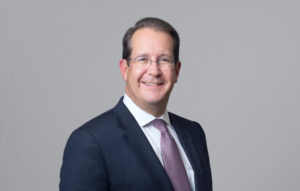For as long as he can remember, Chris Bogart has been interested in the law. As a schoolkid growing up in Toronto, Canada, he enjoyed the thrill of debating, articulating and defending his ideas while cracking open the flaws in his opponent’s logic. In high school, he was an active participant in student government and the Model UN, an educational simulation in which students learn about diplomacy, international relations and the United Nations.
Executive Summary
Litigation finance has been attacked by the insurance industry since its inception for causing “social inflation.” The innovator of the concept in the U.S., Burford Capital’s Chris Bogart, counters that it offers more rational settlements.Insurance Journalist Russ Banham spoke to Bogart about the life and career experiences that sparked the innovation and Burford’s place in the world of litigation finance today.
Before he co-founded Burford Capital, the world’s largest provider of litigation finance, in 2009, these critical thinking skills were essential at Time Warner, where Bogart enjoyed an illustrious legal career as executive vice president and general counsel from 1998 through 2001. He played an indispensable role in such notable transactions as the $7.5 billion acquisition of Turner Broadcasting and the $350 billion merger with America Online.
It was at the publishing and cable TV and Internet giant that Bogart conceived the concept of creating the first litigation finance firm in the U.S. In its most basic form, the idea called for developing a third-party funding company that would finance claimants and law firms in a case in return for a share in the potential recovery. These parties could then pursue claims that otherwise might be abandoned due to lack of funds.
“I knew first-hand at Time Warner the challenges that [corporate] legal departments in companies face when managing litigation—challenges that are fundamentally economic,” Bogart said. “We had lots of money at Time Warner, but we wanted to be spending it on making movies and TV shows and publishing magazines, not on my legal budget.”
At the time, the company pursued litigation the traditional way. “We hired a law firm like my previous employer (Cravath, Swaine & Moore) and paid lawyers by the hour,” he said. “The incurred expenses ran through the P&L, increasing our operating costs and reducing our earnings. By paying for their own litigation, companies end up destroying shareholder value.”
As an example, he cited the legal costs involved in the January 2000 merger of Time Warner and AOL, still the biggest corporate merger in history. The colossal $350 billion merger occasioned an equally large corporate contingency fee, a record $35 million, paid to Cravath, Swaine & Moore. As general counsel, Bogart helped craft the contingency fee. The exorbitant payment got him thinking about alternative ways “to manage a legal budget that was never large enough, to find something pioneering,” he said.
 “There is an unhappy headline-level view in the insurance industry that litigation finance firms like Burford are at odds with insurers and reinsurers, which is not the case at all. We are participants in the same litigation ecosystem as they are and just as interested in it being fair and efficient.”
“There is an unhappy headline-level view in the insurance industry that litigation finance firms like Burford are at odds with insurers and reinsurers, which is not the case at all. We are participants in the same litigation ecosystem as they are and just as interested in it being fair and efficient.”
Chris Bogart, Burford Capital
This journey led to the formation of Burford Capital in October 2009, the month the unique global finance and asset management firm made its debut on the London Stock Exchange via a modest $130 million IPO. In October 2020, Burford Capital joined the New York Stock Exchange, becoming the first legal finance firm to be listed on the NYSE.
Almost from the outset, the insurance industry has been highly critical of litigation finance and by extension Burford Capital. A December 2021 report by Swiss Re argues that the practice, also called litigation funding, contributes to “higher awards, longer cases and greater expenses.” These outcomes factor into “social inflation,” a loosely defined term meaning larger-than-expected insurance claim payouts, causing higher insurance premiums for businesses and people, Swiss Re maintains. The report also contends that litigation finance “diverts a greater share of legal awards to the funder rather than to the plaintiff.” (Related article, “Half of $17B Litigation Funding ‘Industry’ Money Spent in the U.S.: Swiss Re“)
Carrier Management contacted Bogart to respond to the negative views. The former high school debater was eager to counter the criticism, pointing out the value of litigation finance to large corporations, including insurers and reinsurers. As he put it, “There is an unhappy headline-level view in the insurance industry that litigation finance firms like Burford are at odds with insurers and reinsurers, which is not the case at all. We are participants in the same litigation ecosystem as they are and just as interested in it being fair and efficient.”
A Star Litigator Emerges
Few people know Chris Bogart better than Aviva Will. On her second day as a litigator in September 1996 at the white-shoe law firm Cravath, Swaine & Moore in New York, Will met Bogart for the first time. The previous year, she clerked for New Jersey Supreme Court Justice Stewart Pollock, having graduated cum laude from Fordham University’s law school in 1995.
 “I knew joining Burford was a risk, as nobody had ever done what [Chris Bogart] had in mind. But I had tremendous faith in Chris and decided that if I were going to tie myself to a little boat in the ocean, he’s the guy I’d want as my captain.”
“I knew joining Burford was a risk, as nobody had ever done what [Chris Bogart] had in mind. But I had tremendous faith in Chris and decided that if I were going to tie myself to a little boat in the ocean, he’s the guy I’d want as my captain.”
Aviva Will, Burford Capital
“I was on a team with Chris pulling all-nighters that first week on a high-profile Time Warner case led by Bob Joffee, a legendary litigator at Cravath and a mentor to Chris. I thought it was the coolest thing ever,” she said. “Chris was the senior associate [on the team], and he argued one of the key hearings in the case. He did a masterful job, and he wasn’t a partner yet.”
She added, “I remember thinking this guy is relatively young and yet he’s running circles around this very experienced judge and the other side. He grasped and introduced these complex legal concepts in a very clear, coherent and objective way, which is a rare skill. When he left Cravath [to become general counsel at Time Warner], I was surprised. Had he stayed, I felt he would one day run the place. He was a star litigator and a natural leader who could rally the troops.”
Will today is co-chief operating officer at Burford Capital. She joined the firm as a managing director in February 2010, having previously served as assistant general counsel at Time Warner. “It looks like I followed Chris to Time Warner, but he’d gone over to the cable side by the time,” she said. “We were not engaged in any collaborations, although we kept in touch.”
Bogart did indeed go “over to the cable side,” becoming CEO of Time Warner Cable Ventures in January 2001. At the time, it was Time Warner’s largest business, with more than $9 billion in revenues and 30,000 employees. In 2006, Bogart parted ways with Time Warner to lead two different investment funds. In 2009, he reached out to Will to join him at Burford Capital, just prior to its IPO. “Chris’s timing was perfect, as Time Warner was shrinking, selling off bits and parts,” said Will. “I was getting bored. And I thought his concept was brilliant.”
Asked what particularly appealed to her, she responded, “Everyone knows what’s wrong with law firms—their financial structure is so poorly capitalized. I knew joining Burford was a risk, as nobody had ever done what he had in mind. But I had tremendous faith in Chris and decided that if I were going to tie myself to a little boat in the ocean, he’s the guy I’d want as my captain.”
An Old Idea Anew
Litigation funding is a new concept in the U.S., but a version of it existed as far back as the Middle Ages in feudal France. Called champerty, the legal doctrine involved a third party that agreed to materially assist in the prosecution or defense of a lawsuit in return for a share of the proceeds. In the early 20th century, champerty was made illegal in the U.S. and elsewhere in the world for encouraging litigiousness and unnecessarily crowding court calendars. These laws have since been overturned in several states. In June 2020, the Minnesota Supreme Court struck down that state’s prohibitions against third-party litigation funding, acknowledging the practice had demonstrable value.
While Burford Capital was the first litigation finance firm to be incorporated in the U.S., similar firms were previously established in Australia. In the mid-1990s, legislation was enacted in the country that permitted insolvency practitioners to engage in contracts to finance their litigation.
“The business burgeoned first in Australia and then spread to the UK and the U.S.,” said Jerry Theodorou, policy director, finance, insurance and trade, at the R Street Institute, a nonprofit, nonpartisan public policy research organization. “It’s become quite a big business, with Burford Capital the biggest litigation funding company in the world by far, more than double the size of the second largest.”
Swiss Re estimates that litigation finance has become a $17 billion industry globally, with 52 percent of that money being spent in the U.S. A chart on page 10 of Swiss Re’s report lists Burford Capital, with $4.5 billion of assets under management, as the industry’s largest player, followed by Australia’s Omni Bridgeway, with $1.7 billion in assets under management, as No. 2. The 15 firms cited by the report as key players are predominantly domiciled in the U.S., the UK and Australia, with one firm located in Brussels, Belgium.
In Australia in August 2020, growing concerns about the rapid rise in the number of class action lawsuits backed by litigation finance firms compelled the federal government to implement regulations classifying the funding arrangements as “managed investment schemes.” Consequently, litigation finance firms must file for a Financial Services License from the Australian Securities and Investments Commission. Each “scheme” also must be registered with the commission. “The upshot is increased regulatory scrutiny of an industry that enjoyed scant oversight previously,” said Theodorou.
Asked whether similar regulatory scrutiny of litigation finance firms is needed in the U.S., Bogart pointed out that the regulations in Australia were promulgated to address perceived abuses involving plaintiff class actions. “We do not do this business; my clients are corporate clients and big law firms like the one I came from,” he said. “We’re engaged in large-dollar, complex corporate litigation, the kind that is done by large law firms, like complex contract cases, antitrust and IP [intellectual property] matters. Fundamentally, we finance the cost of taking the case forward.”
When Burford Capital funds corporate plaintiffs, the firm is paid if the case is successful and produces damages. When it funds corporate defendants, it is paid based on the case achieving a “certain level of success,” he said, in which its invested capital is returned with “some sort of premium.” He declined to get more specific, citing confidentiality agreements with clients. Although Burford Capital loses its invested capital if a claim fails, the public company’s success rate is approximately 90 percent. “Ten percent of the time the client loses,” he said.
Not All Firms Are Alike
Regarding the insurance industry’s denunciation of litigation finance, particularly Swiss Re’s assertion that it results in longer cases, higher legal expenses, lower net awards for claimants and social inflation, Bogart said the criticism, insofar as Burford Capital, is misplaced, for two reasons.
“Insurers complain about social inflation arising out of enhanced jury verdicts, which is something that has nothing to do with litigation funding,” he said. “I haven’t been persuaded empirically that it does. But if, in fact, it does exist, there are myriad socioeconomic causes behind a jury’s increased distrust for corporations and their insurers” that factor into longer cases, higher legal expenses, lower net awards, etc.
The second reason is more nuanced, he said. “Prior to the advent of litigation finance, there were instances where resources were imbalanced between the litigants, which led to the resolution of litigation at values below their fair value. I represented some very large companies like General Electric, IBM and Time Warner. The playbook called for wearing down the other side if it had less resources.”
Litigation finance levels the playing field, in that both parties have access to funding they otherwise would not, eliminating the playbook to produce fairer litigation value outcomes, he said.
Another criticism of litigation finance focuses on Burford Capital’s and Omni Bridgeway’s publicly traded status, which may be a conflict of interest, as the companies have a duty of care to shareholders.
“If you have a third-party source of funding inserting itself and possibly steering the course of litigation, decisions may be driven by a profit motive that is antithetical to the plaintiff,” said Theodorou. “The plaintiff may want to settle for $500,000, but the third party wants to continue pressing for a $5 million verdict—one that it may not win. I’ve seen Burford’s profit margins, and they’re in the high-20s, which is 900 basis points over the profit margins of venture capital.”
Asked to provide a response, a Burford Capital spokesperson said, “This hypothetical is flawed because, at Burford, we act as passive investors and do not control litigation strategy or settlement decision-making.”
Bogart emphasized several times that Burford Capital does not fund consumer litigation, although he acknowledged that the company has funded mass tort actions in the past. “These cases are not our ‘bread and butter,'” he said. “We work with 91 of the world’s 100 largest law firms. They have both large and smaller corporate clients coming to them with complex legal matters involving millions of dollars. This is not routine business litigation.”
Will is blunter in her rebuttal to the insurance industry’s criticism: “I’ve seen other versions of the Swiss Re report for some time now. We’ve had critiques coming at us since Day 1. Any time you disrupt a market and the status quo, doing something new that other people want to stay the same, you must question their motivations.”
She added, “Burford does not do auto collision claims. We do commercial legal finance, helping to level the economic playing field by creating a more rational environment for decision-making, as opposed to decisions based on who starts out with the biggest pot of capital to bang at the other side. Our job is to tease out the claims that should be litigated, funding them to the point where both sides arrive at a more rational settlement value.”
An October 2021 report by Assured Research, a research and advisory firm focused on insurance matters, appears to separate Burford Capital from other litigation finance firms with different claims and clients. The report states: “Commercial litigation funders focus on business-to-business claims involving disputes over intellectual property, patents, antitrust claims, or esoteric trade credit disputes. There are surely exceptions and perhaps investments made in mass tort claims, for instance, but insurers looking for the root cause of nuclear verdicts in bread-and-butter liability insurance products should focus attention elsewhere.” (See related textbox, “Three Types of Financers”)
Although an article in a London business newspaper appears to suggest that Burford Capital funded a case involving the divorce of the ex-wife of a high-profile Russian billionaire, the article is misleading, as the company’s litigation finance arm was not engaged in the matter. Rather, its specialist asset recovery team, a separate business unit, secured the debtor’s financial compliance with the final judgment of the court.
Since Burford Capital is a publicly traded company in both the U.S. and the UK, shareholders are privy to the work it takes on. Asked how the company selects the cases it funds, Bogart said, “We employ more than 60 lawyers, whose fundamental job is to conduct due diligence on these matters to determine the ones we should finance. Ultimately, the decision is made by our internal investment committee, the same way this operates in a private equity firm.”
Looking back over the growth of Burford Capital since its 2009 formation—from a single office and a team of five people to offices today in New York, London, Chicago, Washington, Singapore and Sydney and more than 140 employees—Bogart may feel a measure of pride in lighting the way forward. But he chalks up the company’s success to the intrinsic value of litigation finance.
“Given my work prior to Burford, I was confident there would be significant demand for what we put together,” he said. “Nevertheless, I do think it exceeded my expectations, affirming the need for a financial solution that wasn’t readily available to corporate clients.”





















 Legal Finance and Insurance: From Confusion to Collaboration
Legal Finance and Insurance: From Confusion to Collaboration  Water Leaks, Frozen Pipes Top List of Small Business Claims: The Hartford
Water Leaks, Frozen Pipes Top List of Small Business Claims: The Hartford  Why Insurance Telematics Integrations Fail
Why Insurance Telematics Integrations Fail  Police Recover Swallowed Fabergé Pendant 6 Days After it Was Stolen
Police Recover Swallowed Fabergé Pendant 6 Days After it Was Stolen 
